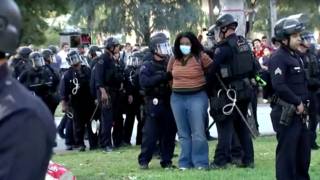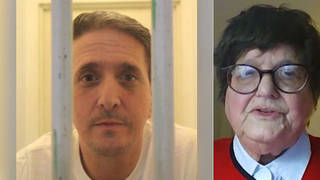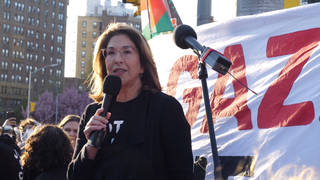
Related
Guests
- Baher Azmylegal director of the Center for Constitutional Rights.
Former U.S. Supreme Court Justice John Paul Stevens died last week at age 99, almost a decade after retiring from the high court. Stevens was nominated in 1975 by Republican President Gerald Ford, but he came to lead the liberal wing of the court for decades and authored key decisions on cases around presidential powers, national security and campaign financing, among other issues. Stevens said at the end of his tenure on the court that his one regret was a 1976 vote upholding a Texas capital punishment statute that revived the death penalty. Stevens later opposed most death penalty sentences. He retired from the court in 2010 as the second-longest-standing justice. We speak with Baher Azmy, legal director of the Center for Constitutional Rights, about Stevens’s life and legacy.
“He embodied these virtues of compassion, humility and wisdom, which stands in such an obvious contrast to the narcissism and bullying and lies in the White House,” Azmy says of the late justice.
Transcript
AMY GOODMAN: This is Democracy Now!, democracynow.org, The War and Peace Report. I’m Amy Goodman. We turn now to look at the life of the late Supreme Court Justice John Paul Stevens, who died on July 16th at the age of 99. He was buried at Arlington National Cemetery on Tuesday.
Stevens was appointed to the court in 1975 by President Gerald Ford. He was appointed to the federal court by President Nixon. Although a moderate Republican, Justice Stevens led the liberal wing of the Supreme Court for decades and is considered a hugely influential justice, who authored key decisions on cases around presidential powers, national security and campaign financing, among other issues.
In his dissent in 2000’s Bush v. Gore case, Justice Stevens wrote, “Although we may never know with complete certainty the identity of the winner of this year’s presidential election, the identity of the loser is clear. It is the nation’s confidence in the judge as impartial guardian of the rule of law,” he wrote.
At the height of President George W. Bush’s so-called war on terror, Stevens wrote the decision granting Guantánamo prisoners legal rights and access to federal courts, in a case brought by the Center for Constitutional Rights.
In his dissent for Citizens United v. Federal Election Commission, Justice Stevens wrote the decision, quote, “threatens to undermine the integrity of elected institutions across the nation.”
Stevens said at the end of his tenure on the court that his one regret was his 1976 vote upholding a Texas capital punishment statute that revived the death penalty. Stevens later opposed most death penalty sentences. He retired from the court in 2010 as the second-longest-standing justice.
To talk more about John Paul Stevens, we’re joined by Baher Azmy, legal director of the Center for Constitutional Rights, which argued before him at the Supreme Court a number of times.
It’s great to have you with us.
BAHER AZMY: Good morning.
AMY GOODMAN: So, talk about Justice Stevens, this unlikely trajectory of his life, chosen first to federal court by Nixon. Then President Ford said it was his proudest legacy, was choosing John Paul Stevens as the Supreme Court justice.
BAHER AZMY: Yeah. His passing is sad, because, you know, even though he was 99 and lived an incredibly rich life, you can’t help but feel—have this “they don’t make them like they used to” feeling. He just sort of embodied these virtues of compassion, humility and wisdom, you know, which stands in such an obvious contrast to the narcissism and bullying and lies in the White House. And I think he was really committed to the role of judges applying reason and humanity, humaneness, to strengthen democratic institutions. And he had a really profound legacy on the court, both because of his style and his intellect, and the outcomes in cases that still last.
AMY GOODMAN: Fascinatingly, 1973, Roe v. Wade, he wasn’t on the court.
BAHER AZMY: Correct.
AMY GOODMAN: But he was—his confirmation hearing was soon after. And apparently, there wasn’t one question—I mean, this is at a time, supposedly, when the country would have been divided, but the Supreme Court had ruled that abortion was legal, changed the law of the land. He wasn’t asked one question in the Senate about abortion.
BAHER AZMY: Right. Well, I mean, what people forget is, Roe v. Wade was a 7-to-2 decision and not nearly as controversial than as it is now. It became controversial because of the political mobilization of the Christian conservative right as a rallying tool. But as a jurisprudential matter, it was not all that big of a deal in 1973.
AMY GOODMAN: So, go through his key decisions and how he came to be the leader of the liberal wing.
BAHER AZMY: Yeah. I think, you know, I’d start with his really important decisions around executive power and national security during the so-called war on terror, issued two really important decisions—one in Rasul v. Bush in 2004, which rejected the president’s—
AMY GOODMAN: And this is your case, this—
BAHER AZMY: Our case, yes, that we brought.
AMY GOODMAN: CCR’s case. Who was Rasul?
BAHER AZMY: Shafiq Rasul was a prisoner in Guantánamo who was held, like many of them, starting in January 2002, incommunicado, denied access to lawyers or any legal rights whatsoever. So, the Center for Constitutional Rights filed the first habeas corpus petitions, trying to get them access to legal rights. And the case made it up to the Supreme Court. And Justice Stevens, who served in World War II and had clerked for a justice who regretted his vote in the Korematsu internment decision—
AMY GOODMAN: Japanese-American detention.
BAHER AZMY: Japanese-American internment decision—took the lead in ruling that detainees had access to legal rights. And it’s a very technical jurisdictional decision, but it really stands for this very simple proposition, that, you know, in this country, in a democracy, we can’t have prisons beyond the law.
And I think his—the other decision is also very technical, which rejected the Bush administration’s attempt to use these made-up military commissions to try some detainees. Also a very technical, scholarly, learned decision, but, at bottom, it stood for the proposition that when it comes to international human rights and respect for international human rights, the United States is part of a community of nations and needs to respect the rule of law. I think, in the national security spaces, he just rejected the whole sort of notion of American exceptionalism or triumphalism, and believed in these core principles of equality and dignity and respect for law.
AMY GOODMAN: Talk about Citizens United and Bush v. Gore.
BAHER AZMY: Yeah. So, he’s also known for these really powerful dissents. In Bush v. Gore, in which the Supreme Court reached in to resolve a state dispute about the presidential elections, he said the court had no business trying to resolve this political dispute that the Florida courts were resolving themselves and that the political process would resolve themselves. And I think he saw what was ultimately to come, which is such a polarization on the court and such a sort of political grandstanding by the conservatives on the court that he feared for the legitimacy of the court.
And I think the same thing happened in the Citizens United case, which was about the rights of corporations, the unbridled rights of corporations, under the First Amendment, to engage in free speech by spending virtually unlimited amounts in political campaigns. On the one hand, as a matter of sort of process and fairness, he could see that the conservatives reached out to take this case, when these questions weren’t before the court. But more profoundly, because he was so committed to the sort of democratic institutions and the public square, he saw the threat that corporations pose to basic principles of equality and deliberation and, you know, the possibility of consensus and these really basic democratic values he was committed to.
AMY GOODMAN: In his book, The Making of a Justice, John Paul Stevens wrote, “In recent years, my firsthand knowledge of the criminal justice system’s fallibility has reinforced my conviction that the death penalty should be abolished.” Talk about his evolution on this issue—he thought maybe, perhaps, this was one of the most important issues of his career—especially in light of the Attorney General William Barr’s surprise announcement this week that he is doing away with the de facto moratorium on the federal death penalty, wants to execute five people in the next few months—more than were executed with the federal death penalty in over half a century.
BAHER AZMY: Yeah. He voted in 1976—just a couple of years on the court—to uphold the death penalty, a vote he later regretted. And it’s a sort of a testament to him and, frankly, anyone who pays attention to the death penalty, because when you see it in operation, he learned, over time, that it was part of a discriminatory criminal justice system, that it could not be used effectively. I think I recall him once saying the imposition of the death penalty is arbitrary in the way that getting struck by lightning is arbitrary, which is very Justice Stevens.
And like Justice Blackmun—these are both conservative Midwesterners who ascended to the court—that initially voted for the death penalty, they saw in operation what William Barr refuses to see, which is it’s unworkable. And in Justice Blackmun’s memorable formulation, he said, “I shall no longer tinker with the machinery of death.”
AMY GOODMAN: And then I want to turn to 2018, Justice John Paul Stevens writing a piece for The New York Times headlined “Repeal the Second Amendment.” He wrote, quote, “Concern that a national standing army might pose a threat to the security of the separate states led to the adoption of that amendment, which provides that 'a well regulated militia, being necessary to the security of a free state, the right of the people to keep and bear arms, shall not be infringed.' Today that concern is a relic of the 18th century,” Justice Stevens wrote.
He went on to criticize the court’s 2008 ruling in District of Columbia v. Heller. He wrote, “Overturning that decision via a constitutional amendment to get rid of the Second Amendment would be simple and would do more to weaken the N.R.A.’s ability to stymie legislative debate and block constructive gun control legislation than any other available option.” Again, those are the words of Justice John Paul Stevens, calling for overturning, repealing the Second Amendment.
BAHER AZMY: Yeah. So, he wrote an incredibly powerful and learned dissent in the Heller-D.C. gun case, which created, out of kind of whole cloth, individual right to bear arms, a right that a former conservative justice, Burger, said in 1991 was a fraud on the American public perpetrated by special interest groups. I mean, it was just sort of a nonexistent possibility. So he wrote a very powerful dissent. But having lost that battle, I think he doesn’t want to give up the war, and so he called for a repeal of the Second Amendment by constitutional amendment.
And he retired in Florida, and I think, expressly or implicitly, I’m not sure which—I think he was inspired by the Parkland activists in Florida and realized that you can’t live in a democracy when schools are threatened by gun violence and communities are consistently threatened by gun violence, let alone calling it some robust right on the order of the First Amendment or the right to due process. It’s just nonsensical to him.
AMY GOODMAN: So, if you can just reflect on what his presence on the court meant for the court and the country? He would have been replaced by Elena Kagan—he was replaced by Elena Kagan, now the Supreme Court justice.
BAHER AZMY: Yeah. I think he’ll have a really enduring legacy for the sort of rare ability to combine intellect and reason with humility, compassion and humaneness, and to see problems in the real world as opposed to purely ideological problems, and to care about real people. And that’s an incredibly profound legacy, particularly as the court lurches to the right in this ideological, reactionary way.
AMY GOODMAN: Baher Azmy, I want to thank you for being with us, legal director of the Center for Constitutional Rights. He directs all litigation and advocacy around issues related to the promotion of civil and human rights. The Center for Constitutional Rights argued a number of times before the Supreme Court with Justice John Paul Stevens. Justice John Paul Stevens was laid to rest at Arlington National Cemetery this week. This is Democracy Now! I’m Amy Goodman. Thanks so much for joining us.












Media Options